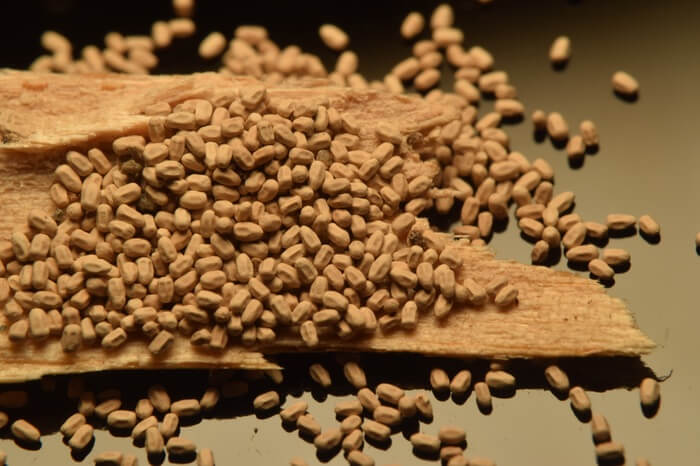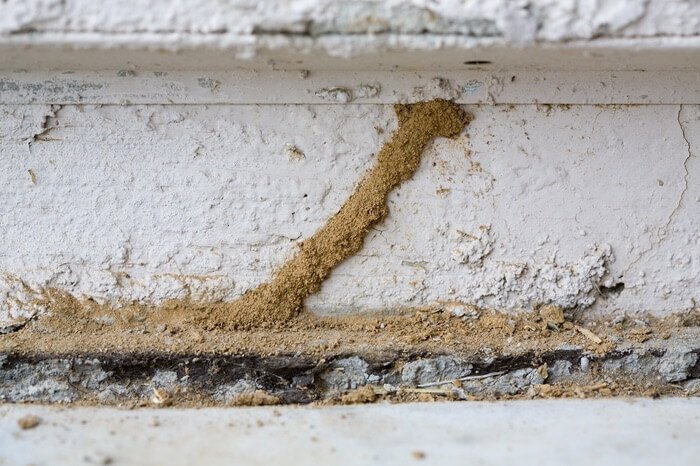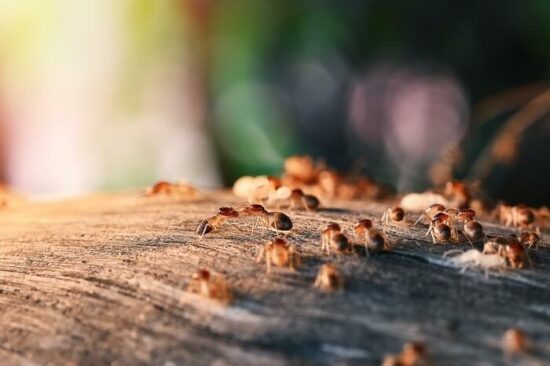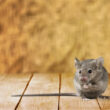It’s important to recognize the signs of termites and the damage they cause if you want to prevent an infestation in your home. Fortunately, this isn’t hard to do!
This guide will help you learn how to tell if you have termites, and what each sign means.
Table of contents
1. Hollowed Out Wood
While termites are tiny, they can cause severe structural damage in large swarms. One of the most unfortunate signs of termites you can come across is sections of hollowed-out and damaged wood.
Termites are wood-boring insects that consume wood from the inside out. They create tiny tunnels, also known as galleries, as they eat. These galleries typically run parallel to the wood grain and cause significant weakening.
You might not see the damage on wooden wall framing or floors. But the moment you touch hollowed wood, you’ll notice the difference.
Those galleries create a resonant sound. In structural components that termites have been eating for a while, there could be so many galleries that applying pressure generates the sound of crumpled paper.
Either way, there’s already a lot of damage. Cutting a cross-section might reveal a honeycomb-like appearance which is a sure sign of termite damage.
2. Droppings
Droppings are another telltale sign of a termite infestation. Also known as frass, droppings are tiny enough to go unnoticed. But if you understand what you’re looking for, you can spot them in seconds!

Typically, frass will appear in large mounds. The individual pellets are less than a millimeter in size. However, most mounds contain the droppings of several termites. As a result, they’ll look like fine powder or light-colored sawdust.
Because their diet consists of cellulose, droppings are typically wood-colored.
The exciting thing about termites is that they like to keep their nests and living spaces relatively mess-free. As they eat their way through the wood and create those signature galleries, they’ll shove the frass out the other end.
Quick Tip: For this reason, the droppings usually accumulate at the entrance of tunnels. If you see a pile of dust-like poop, there’s a good chance that the termites are nearby.
3. Wings That Have Been Discarded
Termites have a pretty unique life cycle. As young termites mature, many develop wings. These termites are also known as “swarmers.”
Once they’re old enough, the swarmers will leave the nest searching for a mate and a new place to set up a colony. Spring is when the swarmers jump into action most. They’re usually attracted to light, but they can enter homes through virtually any access point.
Swarmers don’t hold onto their wings too long. After they find a suitable place to set up shop, they intentionally twist off their wings and leave them behind. The termites will spend the rest of their life wingless as they consume wood and support a growing colony.
There’s no need to keep the wings anymore, so they discard them. That means these wings are evidence of termites in your home.
Take a look around door frames and window sills. You might see a pile of dried-out wings. Many also get trapped in spider webs and corners.
Quick Tip: Both termite wings are the same size, so they’re easy to differentiate from flying ants. A pile often resembles small fish scales.
4. Bodies
In some cases, you might see whole termite bodies. Whether they’re dried out and dead or living, take those sightings seriously!
Seeing termites in your home is pretty rare. These pests like to stay out of sight and live in parts of the house with the fewest foot traffic (which is why signs of termite damage can be so hard to spot). As a result, they can often go unseen for years as they wreak havoc on your home.
One of the biggest problems with termite sightings is that most people don’t realize they’re looking at one of the most troublesome household pests in existence! Most mistake them for simple white ants.
If you come across what you think is a termite, take a close look. Termites are off-white or cream-colored. They also have straight antennae rather than elbowed ones like ants.
For swarmers, pay attention to the wings. On flying ants, the two sets of wings are of different sizes. On flying termites the wings are identical.
Finally, look at the lower half of the insect. Termites have a large waste section. The section that connects the abdomen and thorax is noticeably thicker than the same part on an ant.
The differences are subtle, but you can easily differentiate with a closer inspection. Don’t automatically assume that you have flying ants! Termites do a lot more damage, so it’s better to be safe than sorry.
5. Mud Tubes
Subterranean termites behave a bit differently than common drywood ants. While they can also swarm, these termites navigate using mud tubes.
The tubes serve as a secure transport system between the nest and the wood the termites consume. Typically, the pipeways are a combination of soil and wood bits. The termites form the tunnels for a couple of different purposes.

Subterranean ants migrate up from the soil to find food. They’re most likely to get through foundations to attack basement walls or subfloors. If you have a pier foundation, they can crawl up the vertical pillars to access the floor joists and cause damage.
As they venture to the wood, these termites need extra protection to stay safe. Subterranean species are susceptible to temperature and humidity fluctuations. The mud tubes maintain a comfortable temperature while preventing them from drying out. Plus, it keeps them hidden from would-be predators.
Quick Tip: Take a look around your home’s foundation for this sign of termites. The tunnels are pencil-thin and the same color as the soil below.
6. Warped Doors & Windows
Have you noticed any issues with doors and windows sticking? Many homeowners automatically assume that water damage or temperature changes are to blame. However, it could be a sign of termite damage!
Warping occurs steadily over time, so it’s hard to notice immediately. It’s caused by the constant destruction of wood within the panels or framing. As the termites eat, they produce moisture that causes the wood to swell.
If there’s paint on the door or window, you might notice bubbling or cracking. Some structures will start sagging, which results in difficulties as you try to open and close them. You may even see surrounding elements get all wonky, which is another potential sign that you have termites in your home.
For example, warped and sagging doors often create undue pressure on floorboards and tiles, causing them to pop up slightly.
7. Blistered Wood
Here’s a sign of termites that’s similar to the previous one on our list. While doors and windows become warped and uneven, stationary surfaces might develop noticeable blisters.
The blisters occur due to the same reason. Moisture from eating cellulose and the constant creation of tunnels within the wood affects the exterior. It might look like a small raised section at first.
However, the blister will get progressively worse as the termites eat their way through. Tunnels that are close to the surface will create the most noticeable blisters. Some even break through and reveal the gallery tunnel below!
Blisters can occur on any wooden surface. You’re most likely to see this sign of termite damage on floors, subfloors, and furniture.
8. Swarms
As mentioned earlier, many termite species have swarmers that look for new places to establish a colony. Keep an eye on swarming events! This is a clear sign of termites and a good indicator of potential problems to come.
Swarmers leave the nest a couple of times a year. Usually, it happens once in the spring and again in the fall. The exact timeline will vary based on the termite species and local weather conditions.
While you’ll never know when swarms occur, you can use a rough timeline to learn when to pay attention!
Swarms are brief and usually happen in the early morning or late evening. Those are both times when people aren’t at home, so these swarming events often go unnoticed.
Keep a close eye on the skies during possible swarming seasons. You’ll notice a dense fog of bugs fluttering through the air.
If you have an outdoor light post, you may see swarmers gathering near it. Remember: These termites gravitate to light.
When you notice a swarm occurring, contact an exterminator as soon as possible. Tackling swarms before they find a place to colonize can save you many headaches in the future.
9. The Sound Of Head Banging
Believe it or not, one sign that you have termites in your home is the sound of them banging their heads! It’s a pretty spine-chilling sound that often resonates throughout your walls.
Termites make a variety of noises for different reasons. First, you have the worker bugs. Wood cellulose is tough, so hundreds of tiny termites chewing on it are going to produce noise. It isn’t easy to hear at first, but the sound becomes much more apparent at night.
Soldier termites make noise, too. They’re responsible for protecting the colony. These vigilant soldiers will bang their heads against the wood or shake their bodies violently when trouble arises.
It’s a way to signal danger to the rest of the colony. This behavior is, perhaps, one of the most audible.
Quick Tip: You might even hear termites banging the wood to check the wood. These pests will use their various sensory organs to detect fine vibrations coming from the wood. The banging helps them measure its viability as food.
Conclusion
Signs of termites aren’t always easy to spot, but knowing what to look for will make the process easier. You’ll be fine as long as you remember the tips and tricks in this guide!
If you have any termite-related questions that you’d like to ask us, don’t be shy. Send them over and we’ll help you out.


